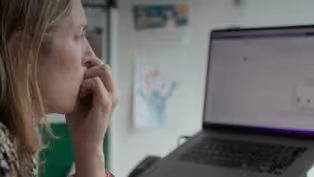
Why Mosquitos Are Humanity’s Deadliest Creature
Clip: Season 50 Episode 17 | 3m 37sVideo has Closed Captions
About 80% of deaths caused by Malaria annually are young children, below the age of five.
Malaria overwhelms the body before it has a chance to fight back, making the development of a vaccine especially challenging.
Problems playing video? | Closed Captioning Feedback
Problems playing video? | Closed Captioning Feedback
National Corporate funding for NOVA is provided by Carlisle Companies and Viking Cruises. Major funding for NOVA is provided by the NOVA Science Trust, the Corporation for Public Broadcasting, and PBS viewers.

Why Mosquitos Are Humanity’s Deadliest Creature
Clip: Season 50 Episode 17 | 3m 37sVideo has Closed Captions
Malaria overwhelms the body before it has a chance to fight back, making the development of a vaccine especially challenging.
Problems playing video? | Closed Captioning Feedback
How to Watch NOVA
NOVA is available to stream on pbs.org and the free PBS App, available on iPhone, Apple TV, Android TV, Android smartphones, Amazon Fire TV, Amazon Fire Tablet, Roku, Samsung Smart TV, and Vizio.
Buy Now

NOVA Labs
NOVA Labs is a free digital platform that engages teens and lifelong learners in games and interactives that foster authentic scientific exploration. Participants take part in real-world investigations by visualizing, analyzing, and playing with the same data that scientists use.Providing Support for PBS.org
Learn Moreabout PBS online sponsorship- Wolves and sharks kill about 10 people per year; Whereas the mosquito, this tiny little animal the size and weight of a grape seed, is responsible for up to a million deaths a year.
(tense music) But it's not the mosquito itself, it's the pathogens that hit a free ride that caused so much suffering, death, and destruction.
And of all the pathogens that mosquitoes carry, by far the most lethal and the biggest killer of humanity has been malaria.
- [Ally] As night falls, this is the most vulnerable time.
That's when the mosquitoes come in.
(tense music) When the mosquito bites, it inject into that child small parasites.
We call them sporozoites.
These spend very few minutes in the blood and then quickly go and start to multiply within the liver.
(tense music) (children playing) And these kids could be playing around.
They could be playing football.
They could be singing with their parents.
(children laughing) Nobody can suspect anything.
But from the liver, within a few days, you could have thousands and thousands of parasite released into the blood.
They attack our red blood cells, destroying them.
And this is what actually give rise to malaria symptoms.
(tense music) That child you saw playing with his friends just a few days ago can quickly become severely sick.
And if not diagnosed and treated very fast, that child might lose life.
(tense music) - [Narrator] It's this process, the way the body is overwhelmed before it has a chance to fight back, that makes malaria so dangerous and the development of a vaccine so challenging.
- We have developed vaccines for other diseases, of course, but most of these are viruses and bacteria, which are much simpler pathogens compared to malaria.
It's a very complex parasite.
- When an infected female mosquito takes a bite and injects sporozoites, malaria parasites, there's about a half hour to two-hour window before the parasites invade the cells in your body and set up infection there.
And that's the window that we're trying to target with our vaccine.
- [Narrator] What the R21 vaccine must do is mobilize an army of antibodies.
- The problem has been to produce enough antibodies to clear all of those parasites very quickly.
When people are infected with malaria, they make antibodies in the blood that stick to the outside of the parasite.
They're meant to stop it in its tracks before they can reach the liver.
But in a natural infection, there just aren't enough antibodies.
- [Narrator] Threatened by just a few invading parasites, our antibody response is usually too little, too late.
But luckily, the malaria sporozoite has an Achilles heel.
To invade the liver, it relies on a coating called CSP, the circumsporozoite protein.
- What we need are large amounts of very specific antibodies that bind as tightly as possible to the circumsporozoite protein.
Then we should be able to stop the parasites.
(tense music)
Video has Closed Captions
Clip: S50 Ep17 | 2m 34s | Today, Malaria is considered a tropical disease, but it wasn’t always that way. (2m 34s)
Inside the Fight To Develop a Malaria Vaccine
Video has Closed Captions
Clip: S50 Ep17 | 4m 18s | These scientists were on the verge of a breakthrough with a promising vaccine nearing approval. (4m 18s)
Providing Support for PBS.org
Learn Moreabout PBS online sponsorship
- Science and Nature

Capturing the splendor of the natural world, from the African plains to the Antarctic ice.

- Science and Nature

Learn how centuries of knowledge helped our ancestors understand the mysteries of space.












Support for PBS provided by:
National Corporate funding for NOVA is provided by Carlisle Companies and Viking Cruises. Major funding for NOVA is provided by the NOVA Science Trust, the Corporation for Public Broadcasting, and PBS viewers.



